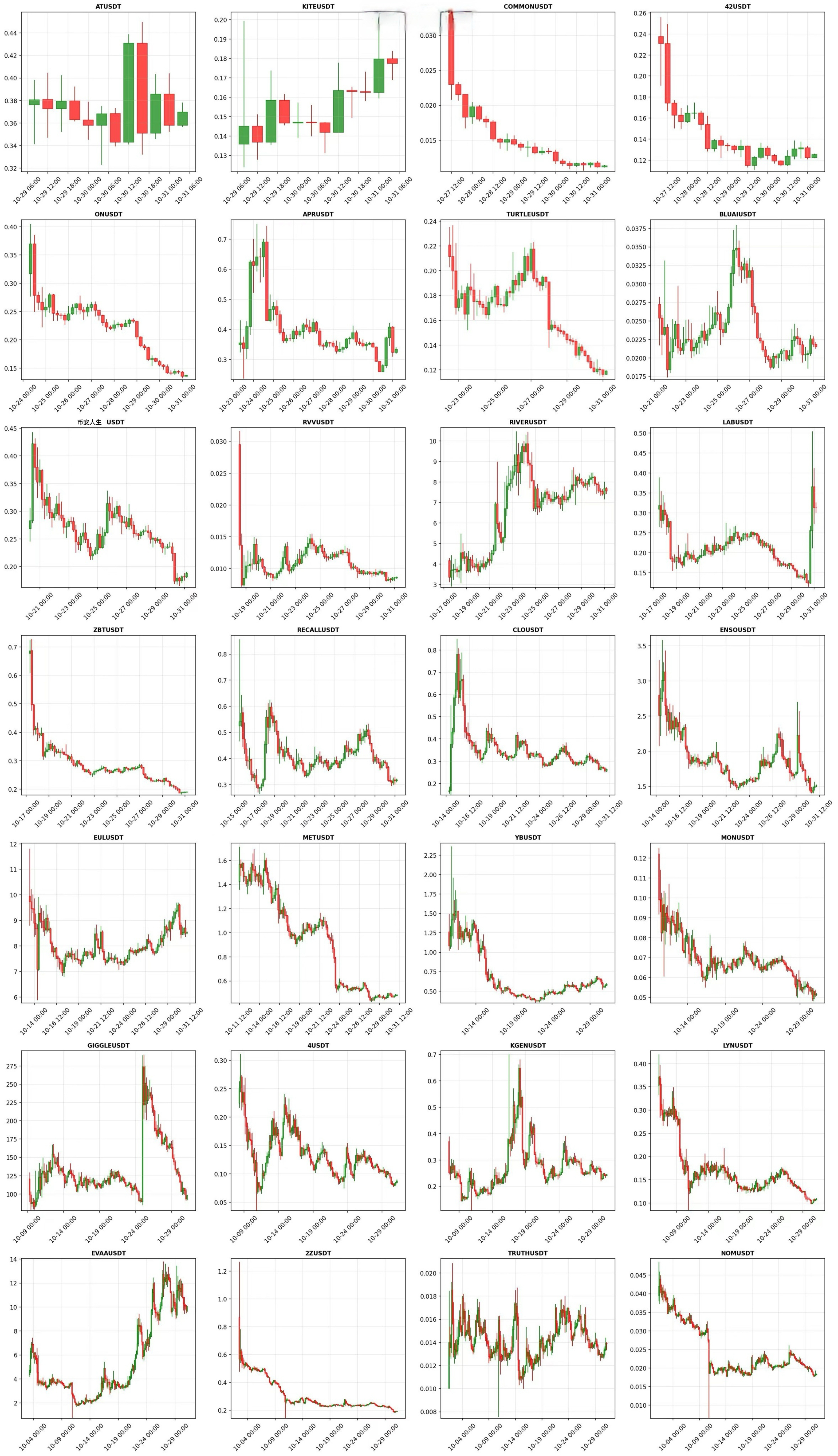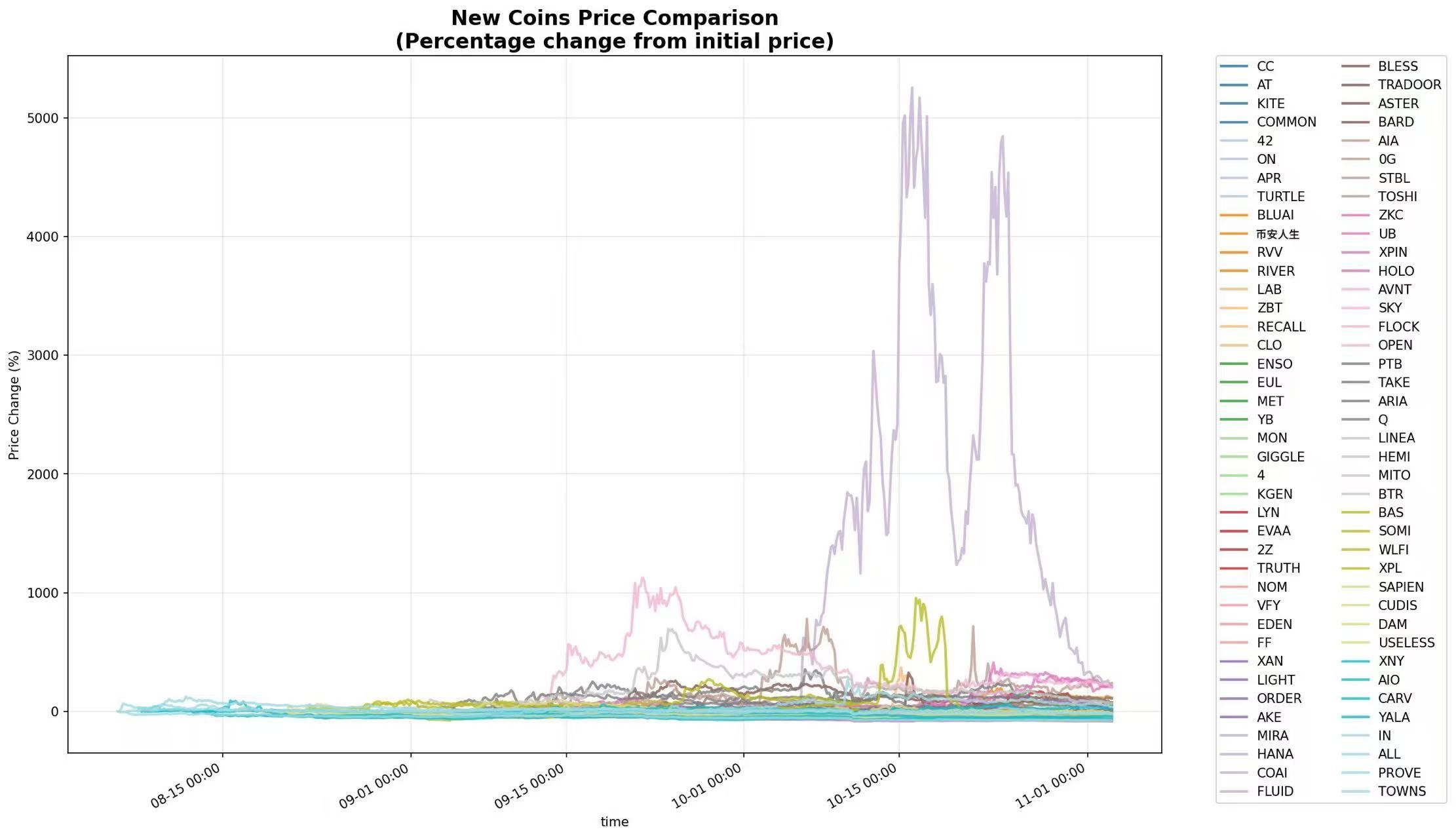Author: @0xBenniee, @gao2750
Data Analysis: @gao2750
Introduction
In the past month, Binance has launched a total of 29 USDT perpetual contract trading pairs, continuing the high-frequency new listing rhythm since the third quarter. Compared to the historical average of about 20 per month, the number of new contracts on Binance has significantly increased in the last three months—19 in August, 32 in September, and 29 in October, maintaining a high level overall. This includes many popular targets from hot sectors such as memes, AI, and public chain ecosystems on BSC. This wave of high-frequency new listings not only reflects the active pace of the exchange in pushing new products but also shows that project parties hope to launch during a window of ample market liquidity to align with TGE for exit or secondary promotion.

This phenomenon of "concentrated new listings" is essentially a test of market absorption capacity and hot topic diffusion efficiency. Comparing the data from the previous two months, it is evident that October entered a distinct "contract intensive period." However, from the price performance perspective, most new contracts quickly retreated after a surge in the first week, with an overall average decline, and only a few strong coins rose against the trend, reflecting an increasing divergence and game of consensus between major players and traders.
During the initial phase, market sentiment briefly warmed up, with some new coins experiencing a trading volume surge several times within the first week of listing, attracting short-term funds to enter. However, the volume then receded, and the correlation of movements within the sector decreased. Strong coins continued to see capital inflow, while weak coins quickly cooled down. The behavior of funds shifted from "emotional speculation" to "structural selection," with dominant forces beginning to shift from retail sentiment to the structural layout of institutional funds.
This article will explore the liquidity harvesting paths and structural opportunities reflected by the new coin wave on Binance in October from three dimensions: the rhythm of new contract listings, changes in funding structure, and the evolution of market sentiment. Through the analysis of core indicators such as trading volume, open interest, and long-short ratios, we hope to reveal how market sentiment has gradually shifted from short-term frenzy to structured games during this "contract intensive period," as well as the layout logic of major funds within it.
Macro Observation: Fund Flow and Market Structure During the Contract Intensive Period

This chart summarizes the total trading volume, open interest (OI), and long-short ratio of the newly launched perpetual contract sector on Binance in October, encapsulating the fund flow and market sentiment changes. Overall, the market structure in October experienced an evolution from "high volume initiation" to "open interest breakthrough."
From the data, the total OI hovered between $200 million and $250 million for nearly half a month, during which trading volume continued to decline, and the market was in a wait-and-see and structural adjustment phase. Until around October 21, open interest surged strongly, peaking close to $350 million, marking a clear "funding increase inflection point." Notably, this phase of open interest growth was accompanied by a continuous shrinkage in trading volume, indicating that the new positions were more from medium to long-term building funds rather than short-term speculation. The dominant forces in the market began to shift from emotion-driven to structural layout.
Phase One: High Volume Initiation (Early October)
Trading volume was at a monthly high, while OI and prices remained in low-level fluctuations. Sentiment was active, but funds were not solidified, primarily driven by short-term speculation.
Phase Two: Low Volume Accumulation (October 5–15)
Trading volume continued to decline, while OI steadily increased, indicating that the market entered a period of chip accumulation, with major funds beginning to tentatively build positions. The "black swan event" on October 11 briefly triggered panic in the market, leading to rapid withdrawals from high-leverage positions, resulting in amplified short-term volatility and a decrease in trading volume. However, this shock, while releasing liquidity risks, also created a more favorable environment for structural funds to build positions. The market makers completed their initial funding layout, preparing for subsequent open interest breakthroughs.
Phase Three: Open Interest Breakthrough (October 20–25)
The OI curve strongly broke through the platform, with prices and long-short ratios rising in sync, significantly increasing fund concentration and forming a sector resonance market.
Phase Four: Volume Shrinkage and Price Stability (End of October)
Trading volume dropped to a monthly low, while OI remained high, and the market entered a phase of high-level fluctuations and structural games. Major funds did not withdraw but were waiting for a new liquidity warming turning point to seek the next round of emotional resonance and volatility opportunities.
Overall, the new contract sector in October exhibited a trading volume and open interest inversion structural characteristic. Funds shifted from short-term speculation to medium-term positions, and the sector was undergoing a transition from emotion-driven to structural fund accumulation.
Structural Differentiation: From Resonance to Selection, the Rise Logic of Strong Coins
With the continuous rise in overall open interest and the convergence of trading volume, significant differentiation began to emerge within the new coin sector. The correlation of movements between strong and weak coins gradually decreased, and the market transitioned from "sector resonance" to "structural selection." Data shows that since mid-October, the prices and open interest of certain coins have risen in sync, forming a typical fund resonance structure; meanwhile, more targets have lost liquidity support amid declining volume, entering a trendless fluctuation.
"Taking EVAA as an example"
After October 11, this coin exhibited structural signals of OI expansion, with the long-short ratio remaining high. This combination of "volume-price resonance + open interest expansion" may indicate concentrated intervention by major funds and a trend waiting for confirmation. While other coins remained in a fluctuating or shrinking state, EVAA's performance first deviated from the overall volatility of the sector, showing clear independent market characteristics.
 From the above chart, it can be seen that the initial concentrated increase in trading volume in mid-October corresponded to the upward node of the open interest curve, indicating that market liquidity was absorbed by major funds in a short time, forming a structural breakthrough. Subsequently, prices entered a steady upward phase, and even as the overall trading volume of the new coin contract sector decreased, EVAA's open interest remained high, indicating that major funds were not in a hurry to cash out but chose to extend the trend cycle through controlled pacing. In contrast, other small and medium contracts, although briefly gaining follow-up buying, lacked continuity and quickly retreated passively.
From the above chart, it can be seen that the initial concentrated increase in trading volume in mid-October corresponded to the upward node of the open interest curve, indicating that market liquidity was absorbed by major funds in a short time, forming a structural breakthrough. Subsequently, prices entered a steady upward phase, and even as the overall trading volume of the new coin contract sector decreased, EVAA's open interest remained high, indicating that major funds were not in a hurry to cash out but chose to extend the trend cycle through controlled pacing. In contrast, other small and medium contracts, although briefly gaining follow-up buying, lacked continuity and quickly retreated passively.
This "stronger gets stronger" structural characteristic indicates that market funds are actively clustering towards more certain targets, with the overall fund utilization efficiency of the sector declining, while the capital absorption capacity of core assets is actually increasing.
From the perspective of fund behavior, the market differentiation in late October represents a liquidity redistribution. Short-term funds have exited high-volatility targets, while major funds have concentrated on a few trending coins to form locked positions, maintaining high open interest. During this phase, the reduction in trading volume no longer represents a retreat in heat but reflects that the market has entered a controlled game and structural rotation mid-state.
Funding Structure Analysis: From Liquidity Range to Harvesting Efficiency

From the overall data of the new coin sector from August to October, the funding structure has shown a clear characteristic of "open interest expansion and trading volume convergence" over the past three months.
The OI rose from $600 million to $1.6 billion, while trading volume retreated from its high, indicating that funds are entering a low-frequency control state.
At the same time, the long-short ratio steadily increased, funding rates turned from negative to positive, and the scale of liquidations decreased, collectively forming a typical
structural accumulation phase after deleveraging.
Defining Liquidity Harvesting
"Liquidity harvesting" is not merely a single act of crashing or unloading but rather a process of utilizing market attention to complete a liquidity cycle.
It can be defined as: the complete funding closed loop from market liquidity being attracted, concentrated, triggered, to being liquidated.
This cycle typically includes four stages:
- Attracting liquidity—guiding attention through new listings, narratives, airdrop expectations, etc.;
- Concentrating liquidity—major players amplify volatility with a small amount of chips, guiding funds to focus;
- Utilizing liquidity—amplifying transactions and pushing prices up during peak emotional phases;
- Liquidating liquidity—funding rates reversing, liquidations, or oscillating unloading completing the cashing out.
This process is a market-wide behavior, not just the movement of a single coin.
Especially in the new coin perpetual contract market, the resonance cycle of funding rates, open interest, and trading volume often corresponds to a process of "liquidity redistribution." If we also include the re-accumulation phase after liquidations (the OI and trading volume recovery period), an average of about 22–28 days can form a complete funding cycle.
From the perspective of the new coin sector, liquidity is extremely concentrated in a few strong coins—about 5% of targets contribute over 70% of trading and volatility.

This indicates that major players do not pursue breadth of coverage but repeatedly create emotional peaks within localized high-volatility areas to achieve maximum liquidity utilization at minimal cost.
The core logic of this structure is—maximizing market-making funding efficiency:
- When the total open interest of new coins approaches the upper range of $200–500 million, market liquidity saturates, nearing the harvesting point;
- When trading volume declines while open interest does not, major players await new narrative triggers;
- When funding rates turn from negative to positive and volatility amplifies, it usually signals the start of a new round of "liquidity utilization."
Therefore, the funding operation logic in the new coin market is not about "continuous investment,"
but revolves around the cyclical process of "creating liquidity → absorbing liquidity → harvesting liquidity."
By dissecting the relative rhythms of OI, trading volume, and funding rates, we can reverse calculate the efficiency range of major funds—currently about 22–28 days.
Within this time window, major players often complete a full loop from creating attention to cashing out liquidity.
Conclusion
Looking back at the new coin cycle over the past three months, from emotional resonance to structural differentiation, from broad netting to precise selection, the market has completed a typical "liquidity cycle":
Funds were attracted, concentrated, released, and then returned to calm. In this process, attention replaced market capitalization as the true pricing power; and the goal of major funds has long shifted from driving the market to managing liquidity.
New coins expose the real mechanisms of the market in the shortest cycles, creating the greatest wealth effect through volatility. It can be anticipated that the current calm is not the end but the starting point of a new cycle. Once a new narrative is ignited, these accumulated funds will become the fuel for the next round of volatility.
What truly deserves attention is not which coin pair will surge, but how funds flow and how emotions are reconstructed. Observing the positions of retail and major players in the liquidity game is key to understanding the market.
Narratives and cycles can repeat, but the laws of fund behavior always leave traces to follow.
Data Source: Binance perpetual contract market public data.
免责声明:本文章仅代表作者个人观点,不代表本平台的立场和观点。本文章仅供信息分享,不构成对任何人的任何投资建议。用户与作者之间的任何争议,与本平台无关。如网页中刊载的文章或图片涉及侵权,请提供相关的权利证明和身份证明发送邮件到support@aicoin.com,本平台相关工作人员将会进行核查。




